Abstract
Camera Model Identification is the digital forensic problem of identifying the source of an image under question, i.e., to map the image to its source device. This assists forensic analysts to map a suspect’s camera with a possibly illegal image repository, or to attribute an image under question to its legitimate source. Counter–forensic attacks to Camera Model Identification techniques, primarily comprise of image anonymization. Image Anonymization is a technique adopted by an intelligent adversary for modifying an image illegitimately, so as to disable attribution of the image to its source; hence to fool a forensic analyst and prevent image source identification. In the recent years, there has been a rapid growth of research interest in the domain of counter–forensics. In this paper, we develop a deep learning based Convolutional Neural Network (CNN) to detect whether an image under question has undergone any form of counter–forensic source anonymization attack. This will enable a forensic analyst to find out whether an image, whose source is being investigated, is authentic, or has it been tampered so as to prevent correct source identification. We deal with three major classes of source anonymization attacks in this paper, viz., Seam Carving, Fingerprint Copying, and Adaptive PRNU Denoising. If an image is detected to have indeed undergone a counter–forensic attack, the proposed model additionally enables detection of the specific class of attack, through multiclass classification. Our experimental results prove that the detection accuracy of the proposed system is considerably high, and it passes the overfitting test too.
Access this chapter
Tax calculation will be finalised at checkout
Purchases are for personal use only
Similar content being viewed by others
References
Fridrich, J.: Digital Image Forensics: There is More to a Picture than Meets the Eye. Springer, New York (2012)
Kharrazi, M., Sencar, H.T., Memon, N.: Blind source camera identification. In: International Conference on Image Processing (ICIP) (2004)
Celiktutan, O., Sankur, B., Avcibas, I.: Blind identification of source cell-phone model. IEEE Trans. Inf. Forensics Secur. 3(3), 553–566 (2008)
Bayram, S., Sencar, H.T., Memon, N.: Improvements on source camera-model identification based on CFA interpolation. In: Proceedings of the WG (2006)
Lukas, J.: Digital camera identification from sensor pattern noise. IEEE Trans. Inf. Forensics Secur. 1(2), 205–214 (2006)
Goljan, M., Fridrich, J., Filler, T.: Large scale test of sensor fingerprint camera identification. In: IS&T/SPIE Electronic Imaging, p. 72540I–72540I (2009)
Li, C.-T.: Digital camera identification from sensor pattern noise. IEEE Trans. Inf. Forensics Secur. 5(2), 280–287 (2010)
Akshatha, K.R., Karunakar, A.K., Anitha, H., Raghavendra, U., Shetty, D.: Digital camera identification using PRNU: a feature based approach. Digit. Invest. 19, 69–77 (2016). Elsevier
Bingchao, X., XiaofengWang, X., JianghuanXi, S.: Source camera identification from image texture features. Neurocomputing 207, 131–140 (2016). Elsevier
Deng, L., Gen, L., Shao, Y., Fei, M., Huosheng, H.: A novel camera calibration technique based on differential evolution particle swarm optimization algorithm. Neurocomputing 174, 456–465 (2016). Elsevier
Chen, C., Stamm, M.C.: Camera model identification framework using an ensemble of demosaicing features. In: IEEE International Workshop on Information Forensics and Security (WIFS) (2015)
Tuama, A., Comby, F., Chaumont, M.: Camera model identification with the use of deep convolutional neural networks. In: IEEE International Workshop on Information Forensics and Security (WIFS) (2016)
Bondi, L., Baroffio, L., Guera, D., Bestagini, P., Delp, E.J., Tubaro, S.: First steps towards camera model identification with convolutional neural networks. IEEE Sig. Process. Lett. 24(3), 259–263 (2017)
Bayram, S., Sencar, H.T., Memon, N.D.: Seam-carving based anonymization against image and video source attribution. In: Proceedings of the IEEE 15th International Workshop Multimedia Signal Processing (MMSP) (2013)
Dirik, A.E., Sencar, H.T., Memon, N.: Analysis of seam-carving-based anonymization of images against PRNU noise pattern-based source attribution. IEEE Trans. Inf. Forensics Secur. 9(12), 2277–2290 (2014)
Quirring, E., Krichner, M.: Fragile sensor fingerprint camera identification. In: IEEE International Workshop on Information Forensics and Security (WIFS) (2015)
Karakk, A., Dirik, A.E.: Adaptive photo-response non-uniformity noise removal against image source attribution. Digit. Invest. 12, 66–76 (2015). Elsevier
Karakuuk, A., Dirik, A.E., Sencar, H.T., Memon, N.D.: Recent advances in counter PRNU based source attribution and beyond. In: Proceedings of the SPIE 9409, Media Watermarking, Security, and Forensics (2015)
Lawgaly, A., Khelifi, F.: Sensor pattern noise estimation based on improved locally adaptive DCT filtering and weighted averaging for source camera identification and verification. IEEE Trans. Inf. Forensics Secur. 12(2), 392–404 (2017)
Gloe, T., Bhme, R.: Dresden image database for benchmarking digital image forensics. In: IEEE International Conference on Acoustics, Speech and Signal Processing (2010)
Gloe, T.: Feature-based forensic camera model identification. In: Shi, Y.Q., Katzenbeisser, S. (eds.) Transactions on Data Hiding and Multimedia Security VIII. LNCS, vol. 7228, pp. 42–62. Springer, Heidelberg (2012). doi:10.1007/978-3-642-31971-6_3
Avidan, S., Shamir, A.: Seam carving for content-aware image resizing. ACM Trans. Graph. (TOG) 26(3) (2007). No. 10
Zeng, H.: Rebuilding the credibility of sensor-based camera source identification. Multimedia Tools Appl. 75(21), 13871–13882 (2016). Springer
Goodfellow, I., Bengio, Y., Courville, A.: Deep Learning. MIT Press (2016). http://www.deeplearningbook.org
Gonzalez, R.C., Woods, R.E.: Image processing. In: Digital Image Processing, vol. 2 (2007)
Zhou, B., Lapedriza, A., Xiao, J., Torralba, A., Oliva, A.: Learning deep features for scene recognition using places database. In: Advances in Neural Information Processing Systems, pp. 487–495 (2014)
Krizhevsky, A.A., Sutskever, I., Hinton, G.: Imagenet classification with deep convolutional neural networks. In: Advances in Neural Information Processing Systems, pp. 1097–1105 (2012)
Chollet, F.: Keras (2015). https://github.com/fchollet/keras
Author information
Authors and Affiliations
Corresponding author
Editor information
Editors and Affiliations
Rights and permissions
Copyright information
© 2017 Springer International Publishing AG
About this paper
Cite this paper
Sameer, V.U., Naskar, R., Musthyala, N., Kokkalla, K. (2017). Deep Learning Based Counter–Forensic Image Classification for Camera Model Identification. In: Kraetzer, C., Shi, YQ., Dittmann, J., Kim, H. (eds) Digital Forensics and Watermarking. IWDW 2017. Lecture Notes in Computer Science(), vol 10431. Springer, Cham. https://doi.org/10.1007/978-3-319-64185-0_5
Download citation
DOI: https://doi.org/10.1007/978-3-319-64185-0_5
Published:
Publisher Name: Springer, Cham
Print ISBN: 978-3-319-64184-3
Online ISBN: 978-3-319-64185-0
eBook Packages: Computer ScienceComputer Science (R0)




